Key Takeaway
Yoga offers effective relief for neck and shoulder pain by reducing stress, improving posture, and strengthening muscles, with specific poses designed to alleviate tension and promote healing.
Due to increased stress, tech device use, and working hours, neck pain is rapidly rising in the western world. In fact, multiple studies have shown that a staggering 70-75% of the population will experience neck pain at some point in their lives!
Moreover, it is not just older adults with weakening joints at risk of neck tension. With the rapidly rising “tech neck syndrome,” more and more younger adults and teenagers are developing neck and shoulder issues.
Luckily, yoga can help significantly relieve neck and shoulder tension, provided you practice the poses safely and respect the proper alignment. This article will look at how yoga can relieve chronic pain and reveal the best yoga postures for the neck and shoulders.
Contents
Causes of tight neck and shoulder muscles

Before we discuss how yoga is effective at relieving neck and shoulder pain, let’s explore what causes pain in these area
Tech neck or poor posture
In our modern-day society, tech neck, a type of repetitive strain injury, is one of the most common causes of neck pain. When we tilt our heads forward to use phones, tablets, and computers, we stress the muscles in the back of the neck and down to the shoulders, causing pain, stiffness, and soreness.
This syndrome caused by overuse is most common among office workers. However, anyone who spends considerable time using tech devices should incorporate yoga neck stretches into their evening routine.
Muscle strains or sprains
Temporary neck pain can be due to a strain of one of the neck’s muscles, tendons, or ligaments. One common strain is a stiff neck, which is the result of sleeping in an awkward position. When this happens, you wake up with limited mobility and feel pain when you try to turn your head.
Strenuous activities that require repetitive movements can also strain a muscle in the neck or shoulders, such as swimming or dancing.
Rotator cuff injury
A common shoulder injury is a tear to the rotator cuff (the group of muscles and tendons that surround the shoulder joint). It is common in baseball, tennis, rowing, and weightlifting. It also affects people with jobs that require repetitive overhead movement of the shoulder joint, like construction workers and house painters.
This injury can make it very difficult to lift or rotate your arm, cause a consistent dull ache, and make it hard to sleep.
Mental Stress
Another modern-day cause of neck and shoulder pain is stress. Whenever we feel high levels of stress, we subconsciously tighten our neck muscles and hunch our shoulders. Doing this for too long can result in pain and stiffness. People with chronic stress can even stay in a constant state of tension.
Other causes of neck and shoulder pain are:
- Age-related conditions like osteoarthritis cause the cartilage between your bones to deteriorate, reducing the joint’s mobility.
- Trauma such as whiplash from a car accident, a fall, or impact from a collision in a contact sport.
- Nerve compression from herniated disks or bone spurs in the cervical spine.
How does yoga help with neck and shoulder pain?
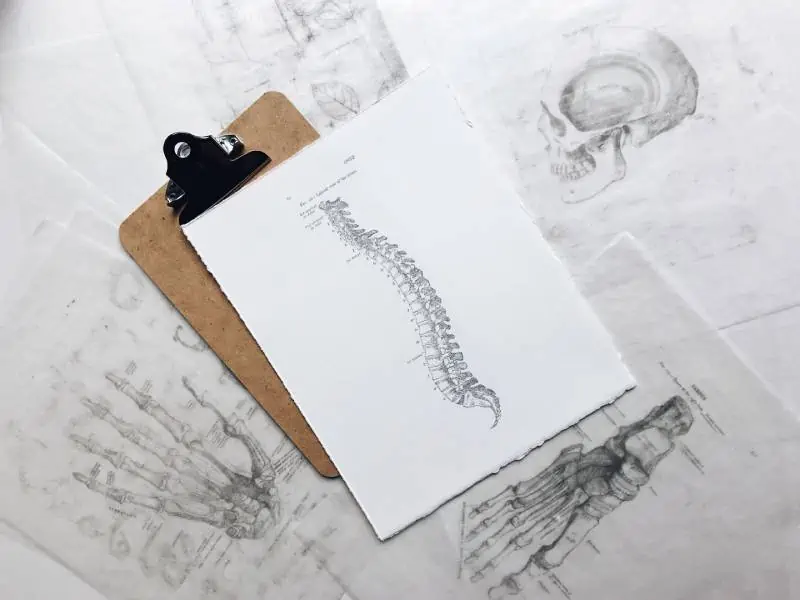
There are several ways yoga can help relieve neck and shoulder pain. Firstly, as yoga reduces stress, the practice can relieve any shoulder tightness or tension caused by it. Many asanas also strengthen neck and shoulder muscles, which improves posture and reduces pain caused by repetitive strain injuries like tech neck.
Medical studies also show yoga to be an effective chronic neck pain relief. Several randomized controlled trials were carried out on chronic neck pain sufferers, and the results were highly positive. All trials noted significant decreases in the intensity of neck pain and functional disability.
Another study showed that yoga was an effective and safe exercise for alleviating shoulder and arm pain in people with breast cancer.
Based on various scientific research, it is believed that yoga can relieve physical pain by down-regulating the hypothalamic pituitary adrenal axis and the sympathetic nervous system. This induces the relaxation response of the parasympathetic nervous system, which is responsible for the body’s healing process. Because of this, yoga is increasingly recommended by doctors for patients with chronic neck pain.
Yoga poses for neck pain relief
Neck rolls
One of the most gentle yoga poses for the neck is neck rolling. In a seated position, drop your chin to your chest and gently roll your head in a circular motion, first to one side, then to the back, then to the other side, before returning to the front. Continue this movement for about 30 seconds, and then rotate in the opposite direction for another 30 seconds.
Be sure to move very slowly, and if you find certain parts of the neck that are particularly tense, linger in those spaces for a few moments.
Neck stretches
After rolling the neck, move into some static stretches. First, drop your head to the right side, allowing the ear to fall towards the shoulder. This might be enough sensation, but if you want to go deeper, place your right hand over your left ear. Don’t apply any pressure here, as the weight of your hand will deepen the stretch.
Repeat the stretch on the left side. Then drop your head down with your chin tucked towards your collarbone. If you want more sensation, interlace your fingers and place the palms of the clasped hands on the back of the head. Again, don’t apply additional force.
Lastly, release your hands and tilt your head back, opening the throat. Bring your thumbs to touch with palms facing forward for a deeper stretch. Place your thumbs under your chin, slightly pressing upwards.

Cat-cow pose
Cat cow pose involves dynamic yet gentle neck flexion and extension, which can relieve tension in the muscles here. Start in a tabletop position with knees directly under the hips and wrists under the shoulders.
On an inhale, drop your belly button to the floor and arch your spine as you look forward and open your chest. As you exhale, suck your belly button into your spinal column as you round your back and tuck your chin towards your chest. Repeat these movements at least five times.
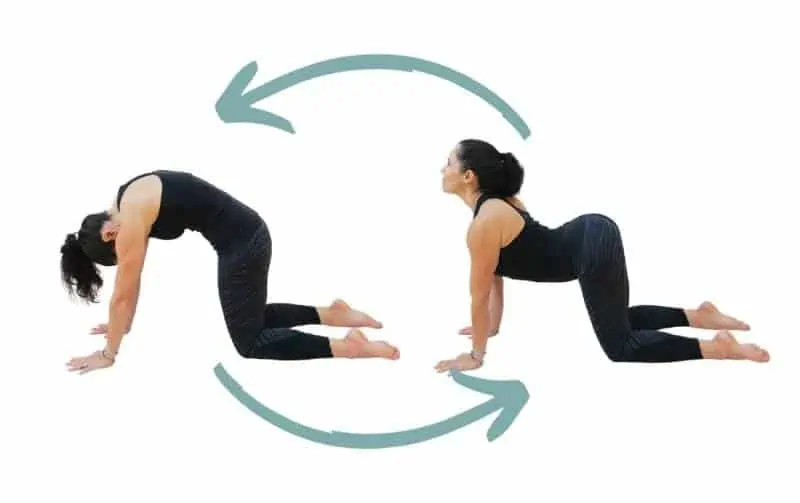
Standing forward bend pose
This foundational yoga asana has many benefits, including releasing tension in the neck and shoulders. In this posture, you tilt your hips forward from a standing position, hanging your head towards the ground. The effect of gravity here promotes total relaxation in the upper body, helping you to relieve tension that you may have been unknowingly holding.
Start in mountain pose with your feet hip-width apart. With your hands on your hips, micro-bend your knees and fold forward on an exhale, folding your torso over your legs. Release your fingers to the floor or a block.

Child’s Pose
Soothing Child’s pose is ideal for combating tech neck and office syndrome. It can relieve tension in the neck and ease headaches and mental fatigue. What’s more, as it relaxes the nervous system, it will melt away stress, relaxing the neck and upper back muscles.
From a kneeling position, tilt your hips forward to bring your upper torso over your thighs. Keep your sitting bones connected to your heels as you walk your hands towards the top of the mat until fully extended. Then release your elbows and forearms to the ground and rest your head on the mat, blanket, or a block.

Yoga poses for shoulder pain relief
Shoulder rolls
Shoulder rolls are one of the most gentle ways to bring movement and relaxation to tight or stiff shoulders. From a standing or seated position, move your hands to your shoulders, fingers facing in. First, draw your elbows up in front of you; then, as you rotate the shoulders, the elbows will come out to the sides and back down towards the ribcage. Continue with this rolling motion for five rounds, then reverse the direction so the elbows come back up and down alongside the chest.
Thread the needle pose
Thread the needle pose can relieve chronic shoulder or back pain as it opens and stretches the shoulders and upper back. The starting position is tabletop, on all fours, with hips stacked over knees and shoulders stacked over wrists.
On an inhale, reach your right arm up to the sky as you open your chest to the right side and look up. Next, exhale to lower the arm and thread it underneath your chest, extending it out past the left shoulder. Next, drop the right shoulder and the side of the head to the ground. If this is not possible, use props for support.
To go deeper, walk with your left hand out in front, arm extended. Alternatively, wrap the left arm around your lower back, reaching the fingers towards the right thigh. Hold here for 5 to 10 breaths, release, and then repeat on the other side.
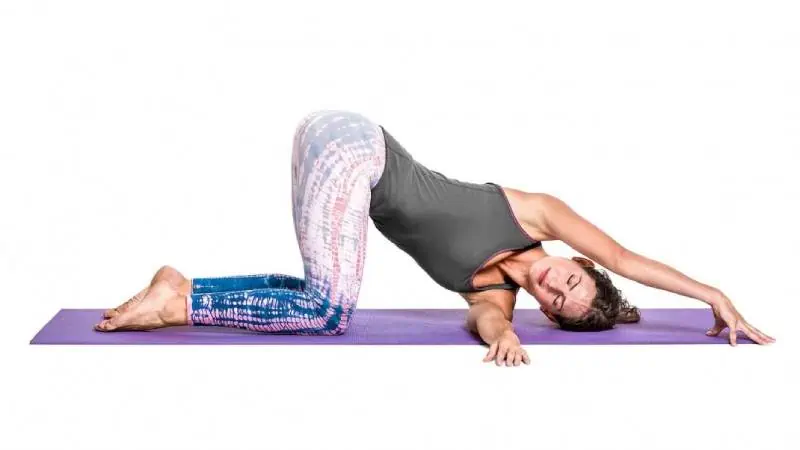
Eagle arms
Eagle arms give a deep stretch to the shoulders and upper back by pulling the shoulder blades away from each other. To perform, bring your arms out in front of you, wrap the right arm under the left, and bend the elbows. Next, bind the arms, trying to bring your fingers to the left palm or wrist.
Once you have the bind, gently pull the elbows up and move the hands away from the face so that you feel the shoulder blades stretch in opposite directions. Take five deep breaths, then release and repeat, this time with the left arm under the right.
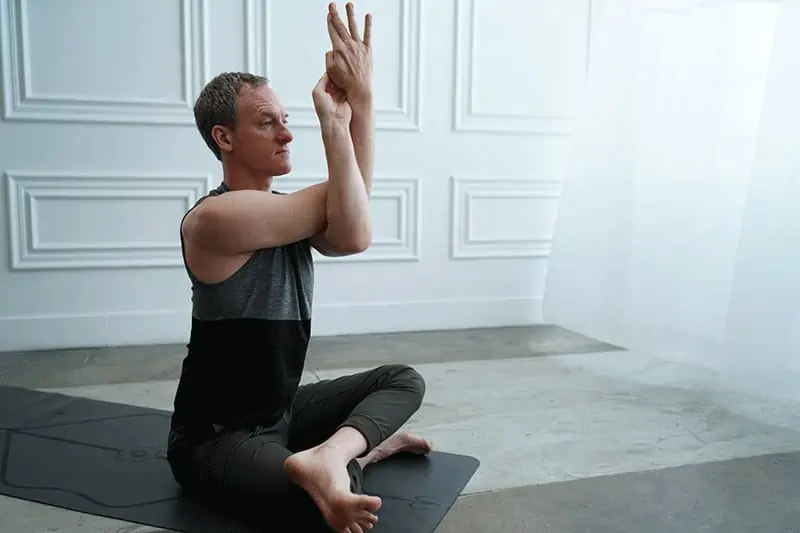
Cow-face pose
The cow face pose is ideal for tight shoulders as it opens the chest, thoracic spine, backs of the arms, and rotator cuff muscles. To perform, reach your right arm up to the sky, bend the elbow, and bring the fingertips to the middle of the upper back. Next, with your left arm extended by your side, bend the elbow so your fingers move towards the spine.
Try to clasp the fingers behind you or hold onto a strap with both hands if this is not accessible. Next, open the chest, point the right elbow up to the sky, and breathe deeply for a few breaths. Then, release and repeat on the opposite side.
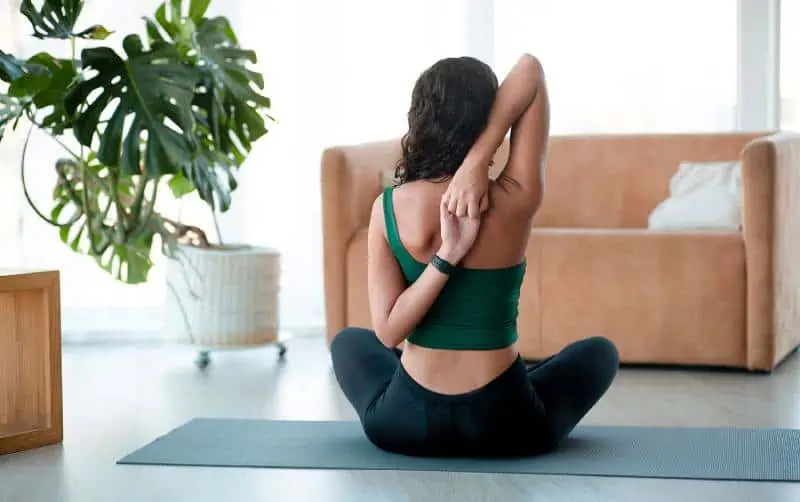
How to avoid neck and shoulder injuries in yoga practice
The above poses effectively relieve pain and muscle tension and strengthen the muscles in the neck and shoulders. However, aside from practicing these yoga routines, you should be careful throughout the rest of your practice to avoid causing pain or injury.
If you have a slight pain in your neck or an old shoulder injury, it’s easy to aggravate it with deep stretches and advanced postures. Here are a few tips for protecting your neck and shoulders during yoga practice.
Keep your gaze down
The direction of your gaze (known as Drishti) is part of the alignment of each asana. Many yoga poses, especially standing postures, call for you to gaze upwards. These include Triangle Pose, Reverse Warrior, and Upward Hands. Some poses, such as Camel Pose or Fish Pose, also require you to tilt your head back.
If you have neck or shoulder issues, you can modify these poses by keeping your gaze straight ahead rather than looking up in standing poses. For Camel, bring your chin towards your chest instead of tilting your head back. If you still feel sharp or stabbing pain, skip the pose altogether.
Rest your head on blocks
Neck pain can occur from hanging your head in specific postures, such as the pigeon pose or various seated forward folds. While this causes no problems for many people, if you are prone to neck pain or have weak neck muscles, this can quickly become painful.
So to prevent additional pain, rest your head on a block or bolster in asanas where your head hangs near the floor. Yoga blocks have three different levels, so you should be able to find the height you need.
An example of this is the Butterfly pose. Most people do not have enough flexibility in the hips and/or back to fold forward enough for the forehead to come to the floor. However, letting the head hang can strain the back of the neck, especially if you hold the posture for a long time, like in Yin or Restorative yoga.
For reclined postures like Fish Pose and Reclined Bound Angle Pose, where the head is traditionally dropped back, place a pillow or block under your head for support.
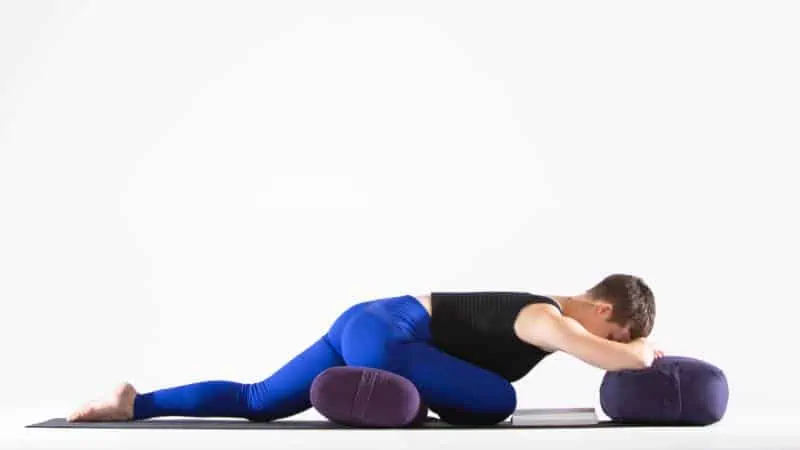
Warm up your shoulders
Shoulder injuries in yoga are, unfortunately, fairly common. The main reason is that the practitioner did not properly warm up their shoulder muscles before attempting deep stretches. If you know you have particularly tight shoulders, it’s wise to focus the warm-up section of your practice on this body part. This is especially important if you plan to do some deep shoulder-opening poses like Dancer’s Pose or Wheel Pose.
Shoulder rolls with a yoga strap are one of the best ways to warm up the shoulder joint as they work on internal and external rotation. Simply hold the belt with both hands directly out in front of you, ensuring the hands are wider than your shoulders. Then, on an inhale, slowly lift the strap above your head. As you exhale, lower it behind you in line with your midback. Next, inhale to lift it above your head, and exhale to bring it down in front of you again.
Do these shoulder rolls for one to two minutes. Adjust your hands on the strap as needed. Move your hands apart to make the stretch more gentle on the shoulders.
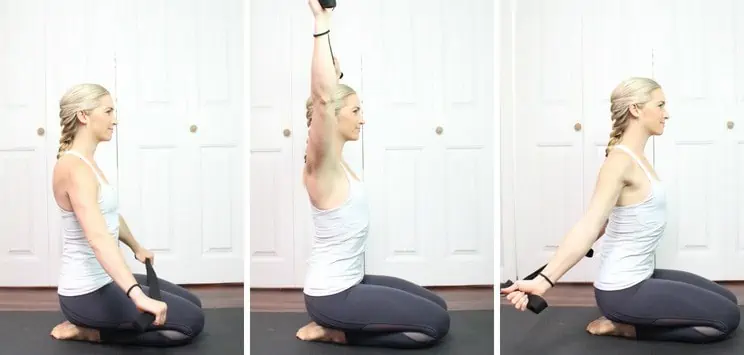
Know and honor your limitations
Another common reason for shoulder injuries during yoga practice is attempting to do an asana that your body is not ready for. If you are new to yoga, it is essential to start with the basics and practice them for a while before attempting intermediate asanas. Try to find beginner yoga classes rather than all levels so you won’t feel tempted to copy the more advanced practitioners.
If you have been practicing yoga for a while and still find particular poses difficult, seek an experienced yoga instructor to help you learn and perform them safely. This is especially important with challenging poses that can easily cause neck or shoulder injuries, such as Headstand, Shoulder Stand, Camel Pose, and Wheel Pose.
Do not attempt to try advanced poses without specific instructions. What’s more, acknowledge that no one, including your yoga teacher, can do every asana, and that’s fine. There are over 80 yoga postures, so if one feels like it compromises your neck too much, leave it and practice the many others instead.
Speak with your yoga instructor
Lastly, if you are attending yoga classes, tell your yoga teacher that you have chronic neck pain at the start of the session. This way, your instructor can advise on which poses to modify or skip to avoid hurting yourself during the practice.
Final thoughts on yoga for neck pain
There are many reasons why we may experience neck or shoulder pain in our modern lifestyles. Regardless of the cause, yoga may be an effective practice for relieving neck pain and tension in the upper body. So if you’re dealing with niggling pains in the neck or shoulders, give the above yoga poses a try and feel the tension release.


